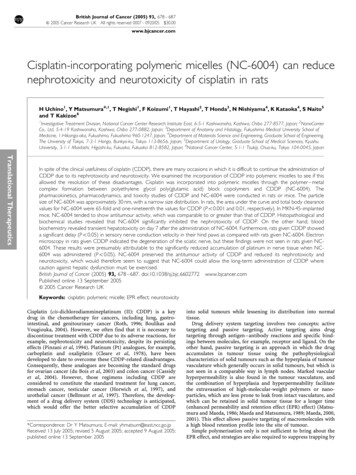
Transcription
British Journal of Cancer (2005) 93, 678 – 687& 2005 Cancer Research UK All rights reserved 0007 – 0920/05 30.00www.bjcancer.comCisplatin-incorporating polymeric micelles (NC-6004) can reducenephrotoxicity and neurotoxicity of cisplatin in ratsTranslational Therapeutics H Uchino1, Y Matsumura*,1, T Negishi1, F Koizumi1, T Hayashi2, T Honda3, N Nishiyama4, K Kataoka4, S Naito5and T Kakizoe61Investigative Treatment Division, National Cancer Center Research Institute East, 6-5-1 Kashiwanoha, Kashiwa, Chiba 277-8577, Japan; 2NanoCarrierCo., Ltd, 5-4-19 Kashiwanoha, Kashiwa, Chiba 277-0882, Japan; 3Department of Anatomy and Histology, Fukushima Medical University School ofMedicine, 1-Hikariga-oka, Fukushima, Fukushima 960-1247, Japan; 4Department of Materials Science and Engineering, Graduate School of Engineering,The University of Tokyo, 7-3-1 Hongo, Bunkyo-ku, Tokyo 113-8656, Japan; 5Department of Urology, Graduate School of Medical Sciences, KyushuUniversity, 3-1-1 Maidashi, Higashi-ku, Fukuoka, Fukuoka 812-8582, Japan; 6National Cancer Center, 5-1-1 Tsukiji, Chuo-ku, Tokyo 104-0045, JapanIn spite of the clinical usefulness of cisplatin (CDDP), there are many occasions in which it is difficult to continue the administration ofCDDP due to its nephrotoxicity and neurotoxicity. We examined the incorporation of CDDP into polymeric micelles to see if thisallowed the resolution of these disadvantages. Cisplatin was incorporated into polymeric micelles through the polymer – metalcomplex formation between polyethylene glycol poly(glutamic acid) block copolymers and CDDP (NC-6004). Thepharmacokinetics, pharmacodynamics, and toxicity studies of CDDP and NC-6004 were conducted in rats or mice. The particlesize of NC-6004 was approximately 30 nm, with a narrow size distribution. In rats, the area under the curve and total body clearancevalues for NC-6004 were 65-fold and one-nineteenth the values for CDDP (Po0.001 and 0.01, respectively). In MKN-45-implantedmice, NC-6004 tended to show antitumour activity, which was comparable to or greater than that of CDDP. Histopathological andbiochemical studies revealed that NC-6004 significantly inhibited the nephrotoxicity of CDDP. On the other hand, bloodbiochemistry revealed transient hepatotoxicity on day 7 after the administration of NC-6004. Furthermore, rats given CDDP showeda significant delay (Po0.05) in sensory nerve conduction velocity in their hind paws as compared with rats given NC-6004. Electronmicroscopy in rats given CDDP indicated the degeneration of the sciatic nerve, but these findings were not seen in rats given NC6004. These results were presumably attributable to the significantly reduced accumulation of platinum in nerve tissue when NC6004 was administered (Po0.05). NC-6004 preserved the antitumour activity of CDDP and reduced its nephrotoxicity andneurotoxicity, which would therefore seem to suggest that NC-6004 could allow the long-term administration of CDDP wherecaution against hepatic dysfunction must be exercised.British Journal of Cancer (2005) 93, 678 – 687. doi:10.1038/sj.bjc.6602772 www.bjcancer.comPublished online 13 September 2005& 2005 Cancer Research UKKeywords: cisplatin; polymeric micelle; EPR effect; neurotoxicityCisplatin (cis-dichlorodiammineplatinum (II): CDDP) is a keydrug in the chemotherapy for cancers, including lung, gastrointestinal, and genitourinary cancer (Roth, 1996; Boulikas andVougiouka, 2004). However, we often find that it is necessary todiscontinue treatment with CDDP due to its adverse reactions, forexample, nephrotoxicity and neurotoxicity, despite its persistingeffects (Pinzani et al, 1994). Platinum (Pt) analogues, for example,carboplatin and oxaliplatin (Cleare et al, 1978), have beendeveloped to date to overcome these CDDP-related disadvantages.Consequently, these analogues are becoming the standard drugsfor ovarian cancer (du Bois et al, 2003) and colon cancer (Cassidyet al, 2004). However, those regimens including CDDP areconsidered to constitute the standard treatment for lung cancer,stomach cancer, testicular cancer (Horwich et al, 1997), andurothelial cancer (Bellmunt et al, 1997). Therefore, the development of a drug delivery system (DDS) technology is anticipated,which would offer the better selective accumulation of CDDP*Correspondence: Dr Y Matsumura; E-mail: yhmatsum@east.ncc.go.jpReceived 13 July 2005; revised 5 August 2005; accepted 9 August 2005;published online 13 September 2005into solid tumours while lessening its distribution into normaltissue.Drug delivery system targeting involves two concepts: activetargeting and passive targeting. Active targeting aims drugtargeting through antigen – antibody reactions and specific bindings between molecules, for example, receptor and ligand. On theother hand, passive targeting is an approach in which the drugaccumulates in tumour tissue using the pathophysiologicalcharacteristics of solid tumours such as the hyperplasia of tumourvasculature which generally occurs in solid tumours, but which isnot seen in a comparable way in lymph nodes. Marked vascularhyperpermeability is also found in the tumour vasculature, andthe combination of hyperplasia and hyperpermeability facilitatethe extravasation of high-molecular-weight polymers or nanoparticles, which are less prone to leak from intact vasculature, andwhich can be retained in solid tumour tissue for a longer time(enhanced permeability and retention effect (EPR) effect) (Matsumura and Maeda, 1986; Maeda and Matsumura, 1989; Maeda, 2000,2001). This effect allows passive targeting of macromolecules witha high blood retention profile into the site of tumour.Simple polymerisation only is not sufficient to bring about theEPR effect, and strategies are also required to suppress trapping by
CDDP-incorporating polymeric micellesH Uchino et alMATERIALS AND METHODSMaterialsCisplatin was purchased from WC Heraeus GmbH & Co., KG(Hanau, Germany). g-Benzyl-L-glutamate N-carboxy anhydridewas purchased from a supplier. N,N-dimethylformamide and m bromide werepurchased from Wako Pure Chemical Co., Inc. (Osaka, Japan).a-Methoxy-o-aminopropyl polyethylene glycol (CH3O – PEG –CH2CH2CH2 – NH2; MW ¼ 12 000) was purchased from NOFCorporation (Tokyo, Japan).Following cell lines, MKN-45, MKN-28, EJ-1, J82, MBT-2,colo201, colo320, HT-29, A549, EBC-1, PC-14, and MCF-7 cellswere purchased from the American Type Culture Collection.Female BALB/c nu/nu mice were purchased from SLC (Shizuoka,Japan). Female Sprague – Dawley rats were purchased from CharlesRiver Japan (Kanagawa, Japan). All animal procedures wereperformed in compliance with the guidelines for the care anduse of experimental animals, which had been drawn up by theCommittee for Animal Experimentation at the National CancerCenter; these guidelines meet the ethical standards required by lawand also comply with the guidelines for the use of experimentalanimals in Japan and the UKCCCR guidelines (UKCCCR, 1998).Preparation of PEG-P(Glu) and preparation of CDDPincorporating polymeric micelles (NC-6004)Polyethylene glycol – P(Glu) block copolymers were synthesisedaccording to the slightly modified procedure of the previouslyreported synthetic method of PEG-P(Asp) (Nishiyama and& 2005 Cancer Research UKKataoka, 2001). g-Benzyl L-glutamate N-carboxy anhydride waspolymerised in N,N-dimethylformamide, initiated with the NH2amino group of CH3O – PEG – CH2CH2CH2NH2, to obtain PEG –poly(g-benzyl L-glutamate) block copolymers (PEG– PBLG).The polymerisation degree of PBLG was determined to be40 by comparing proton ratios between PEG ( OCH2CH2 – :d ¼ 3.7 p.p.m.) and phenyl groups of PBLG ( CH2C6H5:d ¼ 7.3 p.p.m.) in 1H NMR measurement (Mercury plus 300 (VarianTechnologies); solvent: DMSO-d6; and temperature: 251C). Thebenzyl group was deprotected by mixing with 0.5 N NaOH atambient temperature to obtain PEG– P(Glu) as a sodium salt.Cisplatin-incorporating polymeric micelles (NC-6004) wereprepared according to the slightly modified procedure of thepreviously reported synthetic method of CDDP-incorporatingpolymeric micelles (Nishiyama et al, 2003). Briefly, the sodiumsalt of PEG – P(Glu) and CDDP were dissolved in distilled water([Glu] ¼ 4.7 mmol l 1; [CDDP]/[Glu] ¼ 1.0) and were allowed toreact for 72 h. NC-6004 thus prepared was purified withultrafiltration (molecular weight cutoff size: 100 000). The sizedistribution of NC-6004 was evaluated by dynamic light scattering(DLS) at 231C using the NICOMP 380 ZLS particle sizer (ParticleSizing Systems, Santa Barbara, CA).Release of CDDP from NC-6004 dissolved in salineNC-6004 was dissolved in saline and was then incubated at 371C. In all,80 ml of the solution was then harvested at 3, 6, 24, and 96 h after theonset of incubation. The release of CDDP from NC-6004 in the solutionharvested at 371C was quantified by gel permeation chromatography(column: Waters Ultrahydrogel 500 (f7.8 300 mm); Waters GPCsystem equipped with a UV detector (310 nm); and eluent: 10 mmol l 1phosphate-buffered 50 mmol l 1 NaCl solution).In vitro cytoxicityVarious human cancer cell lines were evaluated in the presentstudy. The cell lines were maintained in monolayer cultures inDulbecco’s modified Eagle’s medium containing 10% (v v 1) focalcalf serum and 600 mg l 1 glutamine. WST-8 Cell Counting kit-8(Dojindo, Kumamoto, Japan) was used for cell proliferation assay.In all, 2000 cells of each cell line in 90 ml of culture medium wereplated in 96-well plates and were then incubated for 24 h at 371C.Serial dilutions of CDDP and NC-6004 in a volume of 10 ml wereadded, and the cells incubated for 48 or 72 h. All dates wereexpressed as mean7s.e. of triplicate of the date triplicate cultures.The data were then plotted as a percentage of the data from thecontrol cultures, which were treated identically to the experimentalcultures, except that no drug was added.Pharmacokinetics and pharmacodynamics of CDDP andNC-6004Under isoflurane anaesthesia, a polyethylene catheter was insertedinto the right internal jugular vein of female Sprague – Dawleyfemale rats. Rats (n ¼ 3) were given a single intravenous (i.v.)injection of CDDP (5 mg kg 1) or NC-6004 (an equivalent dose of5 mg kg 1 CDDP) via the tail vein. At 5, 15, and 30 min, as well asat 1, 4, 12, 24, and 48 h after injection of each drug, blood (0.2 ml)was collected into a heparinised microtube via the polyethylenecatheter. The blood samples were centrifuged (1000 g) for 10 min atroom temperature to obtain the plasma. The plasma samples werestored below 801C until the analysis. In a tissue distributionstudy, rats were injected i.v. with CDDP (5 mg kg 1) or NC-6004(an equivalent dose of 5 mg kg 1 CDDP) via the tail vein, andwere then killed in groups of three animals at 10 min, at 1, 6, 24,and 48 h, and on day 7 day after injection of each drug underintraperitoneal pentobarbital anaesthesia (50 mg kg 1). Variousorgans (kidney, liver, spleen, heart, lung, small intestine, colon,British Journal of Cancer (2005) 93(6), 678 – 687Translational Therapeutics679the reticuloendothelial system (RES) and to enhance the bloodretention profile (Klibanov et al, 1990, 1991; Allen, 1994; Gabizonetal, 1996; Lasic, 1996). Polyethylene glycol-tagged liposomaladriamycin (Doxils) has recently been reported as a clinicalsuccess (Orditura etal, 2004). We have recently been conductingresearch dedicated to the development of polymeric micellescapable of incorporating anticancer drugs (Yokoyama et al, 1990,1991, 1999). The Phase I clinical trial of adriamycin-incorporatingpolymeric micelles has been completed (Matsumura et al, 2004).Furthermore, in an animal model, the plasma and tumour areaunder the curve (AUC) values for taxol-incorporating polymericmicelle (NK105) showed 85- and 25-fold increases, respectively,as compared with those for taxol. Therefore, NK105 showedsignificant enhancement (Po0.001) of the antitumour activity offree taxol and a significant reduction (Po0.05) in its neurotoxicity(Hamaguchi et al, 2005). Based on these results, the Phase I clinicaltrial of NK105 is currently being conducted at the National CancerCenter Hospital, Tokyo. We have also been conducting researchdedicated to the development of CDDP-incorporating polymericmicelles and have made a number of improvements, in the in vivoantitumour activity, reduction of nephrotoxicity, particle size,and particle size distribution as variables (Nishiyama and Kataoka,2001; Nishiyama et al, 2001). Consequently, we discovered thatblock copolymers, which react with CDDP, acquire a long bloodretention profile with the use of polyethylene glycol poly(glutamicacid) block copolymers (PEG – P(Glu)) (Nishiyama et al, 2003). Inthe present study, we used the final development of the technologyto prepare CDDP-incorporating polymeric micelles (NC-6004) inan attempt to investigate the following objectives: (1) calculation ofpharmacokinetic (PK) parameters in a detailed PK study of CDDPand NC-6004 in rats; (2) a comparison between CDDP and NC6004 with respect to their antitumour activity in a human cancercell line; and (3) a detailed comparison between CDDP and NC6004 with respect to nephrotoxicity and neurotoxicity, whichconstitute the dose-limiting factors of CDDP.
CDDP-incorporating polymeric micellesH Uchino et al680Translational Therapeuticsand stomach) were dissected. The organ samples were stored below 801C until the analysis. Female BALB/c mice were inoculatedsubcutaneously on the back with 106 MKN-45 cells (UKCCCR,1998). After 10 days, when the tumour size had reachedapproximately 50 mm2, mice were injected i.v. with CDDP(5 mg kg 1) or NC-6004 (an equivalent dose of 5 mg kg 1 CDDP)via the tail vein and were then killed in groups of three animals at10 min, at 1, 6, 24, and 48 h, and on day 7 after injection of eachdrug. The tumours were dissected and stored below 801C until theanalysis. The plasma samples were diluted with 0.1 N HCl, vortexed,and analysed for elemental Pt by frameless atomic absorptionspectrophotometry (FAAS). The tissue samples were decomposedby heating in concentrated nitric acid, evaporated to dryness, andredissolved in 0.1 N HCl. Elemental Pt was measured by FAAS.The PK parameters were calculated using noncompartmentalanalysis (WinNonlin standard software, version 3.1; PharsightCorporation, Palo Alto, CA, USA). The following PK parameterswere obtained: AUC, maximum Pt concentration (Cmax), time toobtain Cmax (Tmax), total body clearance (CLtot), terminal half-lifeof Pt (t1/2z), and steady-state volume of distribution (Vss). The areaunder the tumour concentration – time curve (tumour AUC) wascalculated based on the trapezoidal rule up to 48 h. The parameterswere calculated using the following equations:AUC0 twas calculated by the trapezoidal rule to the last measurable datapoint:Z1AUC0 inf : ¼ CðtÞdt0t1 2 zðterminal half-lifeÞ ¼ 0:693 lzlz: first-order rate constant associated with terminal portion of thecurve)CLtot ¼ Dose AUC0 inf :Vss ¼ MRT CLtot ðMRT : mean residence timeÞIn vivo antitumour activityAntitumour activity was evaluated using nude mice implanted witha human gastric cancer cell line MKN-4. BALB/c nu/nu femalemice (aged 6 weeks) were inoculated subcutaneously with 106MKN-45 cells on the right dorsal skin. After 3 days, when tumourdiameter had reached approximately 3 mm, tumour-bearing micewere allocated randomly to drug administration groups of sixanimals each. The drugs were administered as follows: animals inthe CDDP group were given doses of 0.5, 2.5, 5 mg kg 1; animals inthe NC-6004 group were given doses of 0.5, 2.5, and 5 mg kg 1; andanimals in the control group were given the 5% glucose solution.Cisplatin or NC-6004 was administered to mice at any of the abovedose levels per dose every 3 days. Antitumour activity wasevaluated in terms of tumour size by measuring two orthogonaldiameters (a b: a, long diameter; b, short diameter) at varioustime points. Animals were killed by cervical dislocation whenthe tumour size reached approximately 15 mm (UKCCCR, 1998).Changes in body weight were also monitored for the mice whichwere used in the present study.Nephrotoxicity and hepatotoxicity of CDDP and NC-6004Under isoflurane anaesthesia, five groups of Sprague – Dawleyfemale rats (aged 6 weeks; 185 – 215 g initial body weight) weregiven a single i.v. injection of 5% glucose (n ¼ 8), CDDP at a doseBritish Journal of Cancer (2005) 93(6), 678 – 687of 10 mg kg 1 (n ¼ 12), NC-6004 at a dose of 10 mg kg 1 on aCDDP basis (n ¼ 13), or NC-6004 at a dose of 15 mg kg 1 on aCDDP basis (n ¼ 8). Samples of blood and major organs weretaken on day 7 after administration (UKCCCR, 1998). In the caseof administering NC-6004 at a dose of 10 mg kg 1 on a CDDPbasis, five samples of blood and major organs were taken on day 14after administration. The organs were immersed in 10% formalinsolution. In each blood sample, plasma concentrations of bloodurea nitrogen (BUN), creatinine, glutamic oxaloacetic transaminase (GOT), and glutamic pyruvic transaminase (GPT) weremeasured by SRL Laboratories (Tokyo, Japan). In addition, WBCand platelet were counted for blood samples 7 and 14 days aftereach drug administration in SRL Laboratories (Tokyo, Japan).Evaluation of neurotoxicityThe severity of neurotoxicity was assessed by electrophysiologicaland histopathological procedures. Under isoflurane anaesthesia, rats(n ¼ 5) were given CDDP (2 mg kg 1), NC-6004 (an equivalent doseof 2 mg kg 1 CDDP), or 5% glucose, all i.v., twice a week, to a totalof 11 administrations. Electrophysiological measurements wereconducted at week 6 after the first administration, using the methoddescribed previously (McKeage et al, 1994; Screnci et al, 2000).Under light anaesthesia with phenobarbital, responses were evokedby stimulating the sciatic nerve at its notch and the tibial nerve atthe ankle of the right hind paw, using a percutaneous needleelectrode. The plantar muscle H- and M-waves were recorded usinga pair of superficial silver – silver chloride electrodes applied to thesole and dorsum of the hind paw. H-response-related sensory nerveconduction velocity (SNCV) was calculated by dividing the distancebetween the stimulation sites at the sciatic notch and ankle by thedifference in H-response latency after stimulation at the ankle andsciatic notch. M-response-related motor nerve conduction velocity(MNCV) was calculated by dividing the distance between thestimulation sites at the sciatic notch and ankle by the difference inM-response latency after stimulation at the sciatic notch and ankle.At week 7 after the initial administration, rats under deepanaesthesia with phenobarbital were subjected to intracardiaccatheterisation and were rinsed with saline, followed by perfusionwith 4% glutaraldehyde in 0.12 M PBS. Subsequently, a segment ofthe sciatic nerve was carefully removed. One part of the sciatic nervewas post-fixed with 4% glutaraldehyde in 0.12 M PBS for 24 h andwas then embedded in epoxy resin as described previously(Cavaletti et al, 1992). The remaining parts of the sciatic nervewere immersed in a 10% formalin solution. Semi-thin (1 mm thick)and thin sections were prepared from the resin-embedded sciaticnerve for light microscopic observation and electron microscopicobservation, respectively.To determine the Pt concentration in the sciatic nerve, rats weregiven CDDP (5 mg kg 1, n ¼ 5), NC-6004 (an equivalent dose of5 mg kg 1 CDDP, n ¼ 5), or 5% glucose (n ¼ 2), all i.v. twice aweek, to a total of four administrations. On day 3 after the finaladministration, a segment of the sciatic nerve was removed. Theremoved sciatic nerve was prepared for ICP-MS analysis asdescribed previously (Screnci et al, 2000). Briefly, the nerve wasimmersed in 1 ml of 70% nitric acid overnight. On the next day, thenerve was digested for 2 h at 901C and Milli-Q was then added to afinal volume of 5 ml. Finally, the Pt concentration in
Cisplatin-incorporating polymeric micelles (NC-6004) can reduce nephrotoxicity and neurotoxicity of cisplatin in rats H Uchino1, Y Matsumura*,1, T Negishi1, F Koizumi1, T Hayashi2, T Honda3, N Nishiyama4, K Kataoka4, S Naito5 and T Kakizoe6 1Investigative Treatment Division, National Cancer Center Research Institute East, 6-5-1











